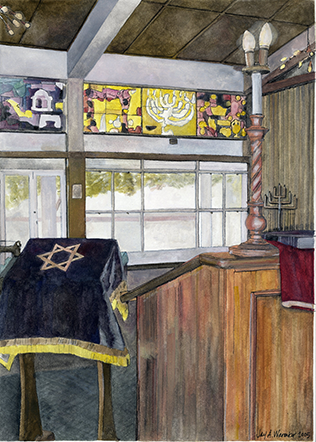 Exterior View (2005), 15” x 11” Watercolor, Jay A. Waronker
Exterior View (2005), 15” x 11” Watercolor, Jay A. Waronker
ZIMBABWE
Progressive Jewish Congregation (Organized in 1959) Synagogue (Completed in 1971) |
|

Interior View (2005), 11” x 15” Watercolor, Jay A. Waronker
|
This structure with its generous grounds, located in an upscale and particularly quiet residential suburban area developed for Bulawayo’s white population during the mid-twentieth century, was built by the Progressive Jewish Congregation (founded in 1959 by Rabbi Moses Weiler) for their communal needs. Its foundation stone was set on October 25, 1970 by Rabbi Curtis E. Cassel. The brick, stucco, and stone structure, an architecturally conservative and unremarkable composition, was designed in a Modern style typical to the period. Stylistically-similar synagogues were built throughout sub-Saharan Africa and the world. It served as the Progressive Jewish base until the community merged with the other Jews in Bulawayo in the early 1980s once the city’s entire Jewish population began to decline in numbers following national independence and an uncertain future. At that time it became essentially a shared community center. The members affiliated with it were Jews of white European origin.
At the time this watercolor was painted, regular prayer services, conducted by a visiting rabbi in town for a couple of years, were held here and at Savyon Lodge, the well run and beautifully maintained Jewish elderly home nearer the central business district. In October 2003, after fire had destroyed the Bulawayo Hebrew Congregation Synagogue just to the west of city center, the social hall of this building was retrofitted as a sanctuary, and prayer services were moved here.
In the 1960s, this Progressive Jewish community held prayer services at the Fairway Hotel (Rhodes Street and 10th Avenue) in a space converted into a small sanctuary. It or other temporary spaces continued to be used until 1971, when the Sinai Center and Louis Treger Hall were constructed. This new and large complex, located in an upscale residential suburban area of town developed for the white population in the 1960s, was dedicated on July 11, 1971.
The Progressive Jewish Congregation was led for a while by Rabbi Curtis Cassell, yet during other periods the community had no formal spiritual leadership. The building with its educational, religious, social, and administrative areas surrounded by generous open grounds, served as the Progressive Jewish base until the community merged with the Bulawayo Hebrew Congregation Jews in the early 1980s. At that time, it became a shared community center.
In 2003, after the massive fire had destroyed the Bulawayo Hebrew Congregation Synagogue in the city center, half the building’s very large multi-use hall was retrofitted as a prayer space measuring 44’ x 51’ x 15’ high. A velvet-draped wood bimah (table where the Torah is read) was brought in and placed centrally in the space, and an ark with a red velvet curtain was positioned against the northern wall. To separate the genders as per Orthodox synagogue custom, the woman sat on a stage already in place behind a mechitza (partition)curtain, and the men congregated on the main area of the room. The sanctuary features a parquet wood floor, wood wainscot and white plaster walls, and a flat plaster ceiling. The sanctuary nicest architectural feature is its stained glass clerestory windows along the south wall. Capturing the ancient Jewish tribes, they were designed by the regional artist Leonora Kibel.
